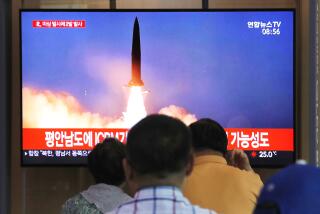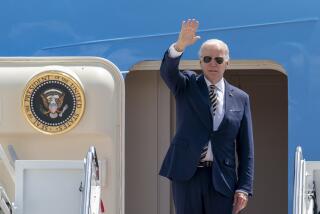Don’t Blame the CIA for Bad Policy
- Share via
WASHINGTON — The year 1948 was one marked by stunning U.S. leadership challenges. Congress passed the visionary Marshall Plan; the Allies did the impossible in pulling off the Berlin airlift; the state of Israel was born fighting, and the first of three wars between Pakistan and India set the stage for a drama of inexorably escalating danger in South Asia.
Fifty years later, U.S. leaders face equally stunning challenges. Europe is heading toward monetary union; the North Atlantic Treaty Organization is welcoming three former adversaries into its security embrace; Israel and its foes are still searching for peace, and the face-off on the Indian subcontinent has just gone unambiguously nuclear.
All these events will test U.S. leadership and imagination, but none so urgently as the high-stakes nuclear game in South Asia. Both India and Pakistan have just ended an atomic guessing game that spanned three decades, and there is no turning back.
So far, Washington has not met the test.
Citing the Central Intelligence Agency for the greatest intelligence failure in a decade when the agency failed to give a heads-up on India’s nuclear testing, the two houses of Congress rushed to launch competing investigations. Calls for “accountability” delayed debate on how the United States might manage the crisis between two important countries, both “friends” of America and both democracies.
But was it just another intelligence failure? Might it not have been a policy failure as well?
It was, to a degree, both, and with a good dose of congressional mischief thrown in.
The CIA did not detect preparations for the first three tests conducted by India. It seems they also missed the second series of tests two days later. Those are the facts. How might that have happened?
It was not difficult. When India prepared to test in 1995, U.S. intelligence dutifully picked up the signs. U.S. diplomats then bundled the data together and laid it on India’s table with a warning of the consequences of carrying out the atomic tests. India blinked and canceled the tests, but kept in place the testing infrastructure.
Indian counterintelligence, having seen our cards and the quality of our satellite imagery, drew the proper conclusions and took countermeasures. They further tightened already-severe controls on their weapons program, apparently shutting off human intelligence efforts against one of the most difficult collection targets in the world.
But what about U.S. satellites?
The myth is that the United States has unlimited satellite resources providing real-time, minutely detailed coverage of any spot on Earth. That’s Hollywood.
The reality is that U.S. imagery assets are strained to their limits, with more demands being placed on them today than at any time in the last decade. Far from being able to monitor the world’s hot spots like surveillance cameras in a convenience store, the intelligence community often has to settle for one pass over an important target every few days. The Indian test site was not covered on a daily basis. India knew that and carried out its final test preparations when U.S. satellites were not overhead.
That U.S. officials again were surprised two days later by the second series of tests bears witness to the difficulty of monitoring a target that is aware of being watched and capable of sophisticated ground deception to fool the imagery analysts even when they are working hard on the job.
Why didn’t U.S. intelligence apply more resources to the Indian nuclear problem?
Because intelligence collectors take their cue from policymakers.
As accounts of recent contacts by U.S. policymakers with their Indian counterparts continue to surface--a dozen at the highest levels since March--it is becoming clear that the most senior levels of the U.S. government judged that India would not “go nuclear,” despite campaign statements by the Indian prime Minister, Atal Behari Vajpayee, that he would “conduct nuclear-weapons tests” if elected. Moreover, a letter from Pakistan’s prime minister, Nawaz Sharif, to President Bill Clinton last month, which expressed grave concern about India’s nuclear intentions, did not alter Washington’s benign view of India.
Given these political currents, it would be rare, indeed, for the intelligence community to go off on its own. India is not Iran; political contact between the United States and India is high-level and frequent. Policy makers call the shots. In this instance, they happened to be wrong.
U.S. intelligence was locked on the Pakistan target over the next two weeks and they were not surprised. Part of the reason is undoubtedly because Pakistan chose to carry out preparations in full view, perhaps to extract concessions from the United States and others. But there was little the administration could offer Pakistan that might deter it from responding in kind to the Indian tests. Congress long ago had tied the president’s hands in dealing with nuclear proliferation on the subcontinent.
The U.S.-Pakistan relationship has always involved more stick than carrot. The one notable exception of amity came during the Soviet occupation of neighboring Afghanistan from 1979-1989. Washington needed Pakistan then, and was willing to overlook certain “shortcomings” for the greater goal of expelling the Soviets from Afghanistan. But within a year of the Soviet pullout from Afghanistan, the honeymoon was over. The United States promptly declared Pakistan a nuclear state and halted all military cooperation, including delivery of 28 F-16 fighters, for which Pakistan had already paid more than half-a-billion dollars. U.S.-Pakistan relations have gone downhill ever since.
Much of the antagonism between the U.S. and Pakistan stems from legislation drawn up by a Congress historically pro-India and hostile to Pakistan. Congressional amendments to defense- and foreign-assistance bills discriminated against Pakistan while winking at India, often through the use of arcane language that distinguishes Pakistan’s more menacing “Islamic bomb” from India’s peaceful one. Pakistan’s distrust of the U.S. is long and deep, and it is little wonder that last ditch efforts to offer security alternatives to testing failed.
Pakistan’s atomic tests should not have surprised anyone. Pakistani Foreign Minister Gohar Ayub had declared that testing was only a question of “when,” not “if.” Reportedly, the Pakistani Cabinet had signed off on testing soon after India’s tests. Senior U.S. intelligence officials expected at least three tests.
Unfortunately, by testing, Pakistan surrendered the moral high ground it briefly held after India’s defiance.
The United States now will have to deal with an immutable reality. India and Pakistan are nuclear states, and that unalterable fact might as well become the basis for crafting a regional solution rather than cause for hand-wringing despair.
The United States must take the lead in crafting a new security concept for South Asia, one that offers reassurances to all parties in the region. That will require a dialogue with Russia, India and Pakistan and, yes, with China. The other declared nuclear powers, Britain and France, can play constructive roles. But it will also be crucial to enlist the assistance of the major nonnuclear powers, as well. Germany and Canada can be important players.
The president has about six months to come up with a such a plan before he visits South Asia in November, a trip that must go forward despite the mounting calls for its cancellation. He can begin discussions with China’s leaders when he visits Beijing next month. But before he goes, he needs new thinking from his national-security advisors and the State Department, and Congress must clear the slate of frivolous legislation that makes the president’s job impossible. Finally, the intelligence community needs more resources to keep everyone honest. A tall order, but the stakes couldn’t be higher.
More to Read
Sign up for Essential California
The most important California stories and recommendations in your inbox every morning.
You may occasionally receive promotional content from the Los Angeles Times.













